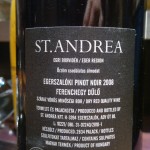 Dear blogger,
Dear blogger,
I have to say that it’s nice to get emails from afar, but it’s even nicer when these emails state that the reason for their contact is due to this blog (yes, this very blog you are reading – for the first time in 3 months – yes, I know..).
I also get emails from winemakers who would like me to taste their wine because they think that I might enjoy them. I have been disappointed a few times I must admit, but when Polish-born Iwo Jakimowicz emailed me one year ago (27/05/2012), I was intrigued. For one, I live in Poland. Two, this Polish-born winemaker claimed to make “natural” wine in Australia. Not only is Australia literally distant, but often their wines were distant as well – from the natural wine world. I knew that they are making strides when it came to making wine with minimal intervention, but these examples were hard to find in Europe, especially in Poland
Read the rest of this entry »

We are in Hungary now. Not the famous Tokaj region centered around the small town of Mad, known for its glorious sweet Aszú wines. Rather we are a bit further south and west. Perhaps the second most well-known wine region in this (perhaps under appreciated) wine producing country. We are in Eger. Home of the “Bulls Blood”, or locally “Egri Bikavér”. Although ecological conditions favor white wine production, the fame of the region lies in its reds.
St. Andrea follows a simple philosophy, one that is not so seldom heard these days: “The quality of the wine is decided in the vineyard”. Not a new way of thinking, but a more and more common way of thinking. A philosophy that for the most part I agree with. You certainly cannot make a great wine without great grapes. But one cannot ignore the wine maker. This is where a wine maker who listens carefully to his grapes can mean the difference between an average, every day bottle of wine and a great bottle of wine. Dr. György Lőrincz (owner/oenologist) says “If an oenologist reaches this level of quality and can maintain it continuously with undiminished energy for decades, his vineyard can become deservedly prestigious, and establish iconic wines that can motivate other enthusiastic oenologists.”
I heard rumors that many consider St. Andrea as the best Pinot Noir producer in the area. 2,834 bottles produced
Date tasted: May 17th, 2011 19:07
Appearance: very light in color, almost rosé like. One of the lightest Pinot’s I have seen in a while. Medium intense reflexes. Young.

 Nose: Wood, forest floor. Oak not abusive to the fruit. Ripe raspberries with smoky hints. Quite open already. Alcohol stings the nose a bit.
Nose: Wood, forest floor. Oak not abusive to the fruit. Ripe raspberries with smoky hints. Quite open already. Alcohol stings the nose a bit.
Palate: good attack and good structure. Medium plus acidity, nice fruit, oak sits around the whole wine, gently coating the tongue and mouth. Surprising freshness. Alcohol is quite fresh and doesn’t dominate the wine. For my palate, the oak is too much a piece of the puzzle. Perhaps the producer intended that this wine be stored a few years, but I’m not sure this is a wine that will improve for the next 5 years in the cellar. Judicious use of oak none the less, but it loses a bit of it’s drinkablity for me because of the oak, unfortunately. Drink now or enjoy over the next 3-5 years.

Date tasted: July 11th, 2009 22:30 (10:30 pm)
Egly-Ouriet has been a personal long time favorite producer of mine. The Champagnes see long lees ageing making them very complex and yeasty. Located in the village of Ambonnay, Francis Egly owns approximately 8ha of vineyards, the majority of which are in Ambonnay. All of the vineyards are classified as Grand Cru and have the reputation for producing some of the best Pinot Noir based Champagnes. Most of the vines average between 30-50 years of age and are farmed using “common sense” principles. In the most recent years, Francis has reduced the amount of chemical fertilizers, herbicides and pesticides. He never fines nor filters his Champagnes.
This specific wine is a still red wine made with Pinot Noir. I am told that Egly-Ouriet produces some of the best wines in the Coteaux Champenois under the guidance of Dominque Laurent. Only about 200 cases are made. 12% Alcohol.
Appearance: Classic light Pinot Noir color with medium plus intensity. I was in a dimly lit place so I can’t be very precise with the appearance.
Nose: Sweet smoke, cedar, oak and minerals. Ripe cherries, red licorice and raspberry. The bouquet reminded me of the small candies and anise seeds you get when you leave an Indian restaurant. Some hints of forrest floor and leaves. Quite complex on the nose. Hints of tobacco. Intensity about medium.
Palate: Cedar and smoke. Raspberries and those same small Indian candies and anise seeds I got on the nose. Great acidity with medium plus length. Good concentration while remaining light and fresh. Great structure with mild oak tannins. Sour cherries. Very elegant. Hints of dried sour plums. This is a very elegant wine with still dominant, sweet, cigar box oak.

23:35
Subtle hints of sulfur emerging, stinging the nose ever so slightly. Hints of rubber. Seems as though the wine is closing and the fruit becoming less obvious. The wine never quite returned to it’s initial glory.
A great wine to have the opportunity to taste. I have tasted this vintage on two diferrent occassions and have been impressed both times. I have also tasted the 1999, but prefer the 1998 for its elegance. This is a well-made Pinot Noir that is drinking well now so if you own a bottle, drink up!





